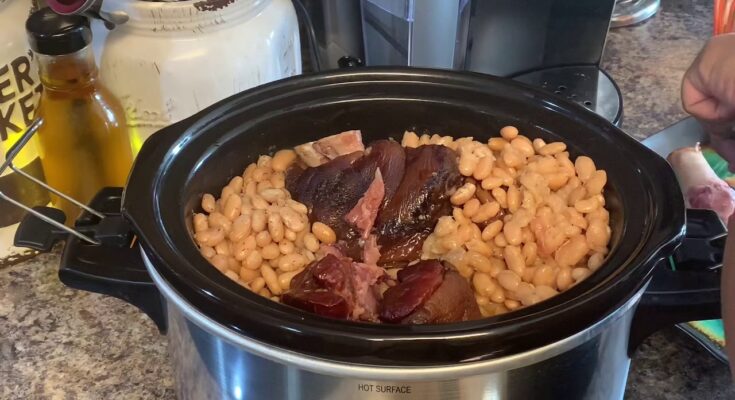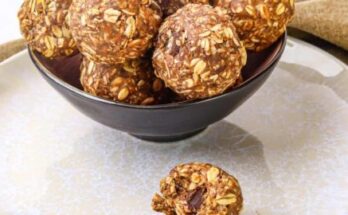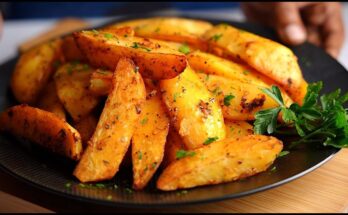Great Northern Beans Recipe: When you think of comforting, hearty, and nourishing meals, Great Northern beans definitely earn their place on the list.
Whether you’re looking to make a wholesome soup, a creamy side dish, or a main course packed with plant-based protein, these mild-flavored beans are a pantry staple you should never overlook.
This step-by-step guide will walk you through preparing them from scratch, with helpful tips, flavorful variations, and all the know-how to master this versatile ingredient.
What are Great Northern Beans?
Great Northern beans are a type of white bean that’s slightly smaller than cannellini beans but larger than navy beans. Their mild, nutty flavor and tender flesh make them a go-to ingredient in countless dishes—from stews to casseroles and even salads. These beans hold their shape well during cooking, so you can simmer them for hours without them turning mushy, which makes them perfect for slow-cooked recipes and hearty meals.
They are part of the legume family, rich in fiber and protein, and low in fat. Because of their neutral flavor, they absorb spices and seasonings incredibly well, turning any simple recipe into a taste explosion.
Why Choose Great Northern Beans for Cooking?
So why not just go for canned beans or some other type? Great Northern beans are ideal for a few reasons:
- Mild Flavor: Their neutral profile means they can go into spicy chili or creamy soups and adapt perfectly.
- Excellent Texture: They become soft without disintegrating—making them ideal for recipes that need a little bite.
- Nutritional Powerhouse: They’re loaded with plant-based protein, fiber, iron, and magnesium. A perfect option for vegetarians and health-conscious eaters.
- Budget-Friendly: A bag of dried Great Northern beans can feed a whole family for just a few dollars.
Ingredients You’ll Need
To get the best out of your Great Northern beans, you’ll need just a few kitchen staples—and maybe a few optional extras if you’re feeling fancy.
Core Ingredients
Here’s what you’ll need to make a simple, classic pot of Great Northern beans:
- 1 lb dried Great Northern beans
- 1 medium yellow onion, chopped
- 3 cloves garlic, minced
- 2 tablespoons olive oil (or butter for a richer flavor)
- 6 cups vegetable or chicken broth
- 1 bay leaf
- 1 teaspoon salt
- ½ teaspoon black pepper
These ingredients will make a delicious, satisfying batch of beans, perfect for eating on their own or adding into other recipes.
Optional Add-ins for Extra Flavor
Want to elevate your bean game? Consider these optional additions:
- Smoked ham hock or bacon for a smoky flavor
- Diced carrots and celery for extra heartiness
- Chopped spinach or kale stirred in at the end
- Paprika or chili flakes for some kick
- Parmesan rind for umami (if you’re going the Italian route)
Mix and match based on what you’ve got in your pantry or your desired flavor profile!
Kitchen Tools Required
Before you start cooking, make sure you have these tools on hand:
- Large pot or Dutch oven – something that can hold a lot of liquid and retain heat well
- Wooden spoon or spatula – for stirring as things cook
- Colander – for rinsing and draining the beans
- Knife and cutting board – to chop your aromatics
- Ladle – for serving the finished product
A slow cooker or Instant Pot can also be used for more hands-off cooking, and we’ll talk more about those methods later in the article.
Preparation Before Cooking
Soaking the Beans
This is the part most people are tempted to skip—but don’t. Soaking your beans not only shortens the cooking time, but it also helps break down some of the complex sugars that can cause digestive issues. Here’s how to do it:
Overnight Soak: Place the beans in a large bowl and cover them with about 3 inches of cold water. Let them soak for 8-12 hours. Drain and rinse before cooking.
Quick Soak Method: If you forgot to soak overnight (it happens), place your beans in a large pot, cover with water, and bring to a boil. Let them boil for 2 minutes, then remove from heat, cover, and let them sit for 1 hour. Drain and rinse.
Both methods work well—so use what suits your schedule.
Rinsing and Sorting
After soaking, pour your beans into a colander and give them a good rinse. Take a moment to sort through and remove any pebbles or damaged beans. This only takes a minute and ensures you’re cooking only the best.
Step-by-Step Cooking Instructions
Step 1: Prepping the Beans
Once your beans are soaked and rinsed, it’s time to get cooking. Start by heating olive oil in a large pot over medium heat. Add chopped onions and sauté until they’re soft and golden, about 5-7 minutes. Stir in the minced garlic and let it cook for another minute until fragrant.
Why start this way? Sautéing aromatics first layers in deep flavor from the beginning, and it’s one of those small steps that make a huge difference.
Step 2: Sauteing Aromatics
This step is where the magic begins. After your onions and garlic are fragrant and golden, it’s time to add depth. You can toss in your carrots and celery now if you’re using them. These veggies soften and release their natural sweetness, which adds body and complexity to your beans.
Let them cook for about 5-6 minutes. If you’re going for a smoky flavor, this is also a great time to add a smoked ham hock, a few strips of chopped bacon, or even a chunk of smoked sausage. The key here is to build flavor in layers. Every stir you make is one step closer to something comforting and delicious.
Step 3: Cooking the Beans
Time to get those beans into the mix!
Pour the soaked and rinsed Great Northern beans into the pot, then add your 6 cups of broth (vegetable or chicken—your choice). Toss in your bay leaf, and bring the whole pot to a gentle boil over medium-high heat.
Once boiling, reduce the heat to low, cover the pot partially, and let the beans simmer for about 60-90 minutes. Check them every 20-30 minutes, stirring gently to prevent sticking and to ensure even cooking.
You’ll know they’re ready when the beans are tender but not mushy. They should have a slight bite, like al dente pasta. Overcooking will make them fall apart, especially if you’re planning to store or reuse them in other meals later.
Step 4: Seasoning to Perfection
You might be tempted to season early, but wait until your beans are fully cooked to add salt. Adding salt too soon can toughen the skin and increase cooking time. Once the beans are tender, stir in your salt, pepper, and any other spices you like—paprika, thyme, a touch of cumin, or even a pinch of cayenne for heat.
This is also the point where you can stir in greens like chopped spinach or kale, or even a splash of lemon juice or vinegar for brightness.
Want to go creamy? Use a potato masher to gently smash some of the beans against the side of the pot, then stir. This releases starch and makes the broth silky and rich without adding any cream.
Step 5: Final Touches
Your beans are almost ready, and now it’s all about fine-tuning. Taste and adjust your seasonings—maybe a little more salt, an extra crack of black pepper, or a drizzle of olive oil. If you added a ham hock or bacon, remove it now, shred the meat if desired, and stir it back in for extra protein and flavor.
Let your pot sit off the heat for about 10 minutes. This lets the flavors meld together beautifully and allows the texture to thicken slightly.
At this point, your beans can be served just as they are—rustic, warm, and satisfying. Or they can become the base for all kinds of recipes: pour them over rice, use them in a bean salad, blend them into a dip, or spoon them beside grilled meats or veggies.
Tips for the Best Great Northern Beans
Avoiding Overcooking
Great Northern beans are tender but can quickly turn mushy if overcooked. To keep that perfect texture:
- Stick to a low simmer, not a rolling boil.
- Stir gently and infrequently to avoid breaking them.
- Test doneness early. Around the 60-minute mark, start taste-testing.
If you’re cooking with meat or other ingredients that need longer, consider cooking them separately or adding them partway through.
Enhancing the Flavor Profile
While the base recipe is great, you can elevate your dish with a few chef-style tricks:
- Deglaze the pan after sautéing aromatics with a splash of white wine or broth.
- Add umami boosters like a parmesan rind, miso paste, or a spoonful of tomato paste.
- Finish with a garnish: chopped parsley, fresh thyme, or a drizzle of herb oil adds freshness and color.
And remember, like most stews or soups, these beans taste even better the next day after the flavors have had time to deepen in the fridge.
Variations to Try
Smoky Great Northern Beans
For a bold Southern-style flavor, start your aromatics with diced bacon or smoked sausage. Add a smoked ham hock or turkey leg while simmering the beans. Season with smoked paprika, garlic powder, and a bit of hot sauce. Serve with cornbread for a comforting, down-home meal.
Creamy Great Northern Beans
Want something more luxurious? After cooking, remove about a cup of the beans and blend them with some broth, then stir it back into the pot. Add a splash of heavy cream, coconut milk, or a few tablespoons of butter. Finish with grated Parmesan and a sprinkle of herbs for an indulgent twist.
Nutritional Value of Great Northern Beans
Great Northern beans don’t just taste amazing—they’re a powerhouse of nutrition too. Whether you’re looking to build muscle, improve digestion, or manage your blood sugar, these beans can do it all.
Let’s break down the key nutrients per 1 cup of cooked Great Northern beans (approximately 180g):
| Nutrient | Amount |
|---|---|
| Calories | 209 |
| Protein | 14.7g |
| Fiber | 12.4g |
| Carbohydrates | 37.3g |
| Fat | 0.8g |
| Iron | 3.6mg |
| Magnesium | 63mg |
| Potassium | 708mg |
Why They’re Great for Your Health
- High in Plant-Based Protein: Great for vegetarians and anyone reducing meat intake.
- Excellent Fiber Content: Promotes gut health and helps lower cholesterol.
- Low Glycemic Index: Ideal for stabilizing blood sugar levels.
- Rich in Minerals: Particularly potassium, magnesium, and iron—essential for heart health, bone strength, and energy.
Because they’re low in fat and high in fiber, Great Northern beans also support weight management, keeping you full longer without excess calories.
Storage and Reheating Tips
Cooked a big batch and have leftovers? No problem—Great Northern beans store and reheat like champs.
Storing in the Fridge
- Let your beans cool completely before storing.
- Transfer to an airtight container and store in the fridge.
- They’ll keep well for up to 5 days.
Freezing for Long-Term Use
- Portion your beans into freezer-safe containers or bags.
- Label with the date.
- They can be frozen for up to 3 months.
- To thaw: leave in the fridge overnight or use the defrost function on your microwave.
Reheating Tips
- Warm gently on the stovetop over low heat.
- Add a splash of broth or water to loosen the texture if it’s thickened in the fridge.
- For a quick fix, microwave in a covered dish for 1-2 minutes, stirring halfway.
Freezing is especially great if you like to meal prep—you can make a large pot and have a ready-to-go protein for weeks.
FAQs about Great Northern Beans Recipe
1. What are Great Northern Beans?
Great Northern beans are medium-sized white beans known for their mild flavor and creamy texture. They’re perfect for soups, stews, casseroles, and even cold salads.
2. Do I need to soak Great Northern beans before cooking?
Yes, soaking is recommended. Soaking them overnight or doing a quick soak (boiling then letting them sit for an hour) helps reduce cooking time and improve digestibility.
3. How long do Great Northern beans take to cook?
If soaked, they typically take 60–90 minutes to cook on the stovetop. In a pressure cooker, they cook much faster — about 25–30 minutes.
4. Can I use canned Great Northern beans?
Absolutely! Canned beans are pre-cooked and a great time-saver. Just rinse them well to remove excess sodium before using in your recipes.
5. What do Great Northern beans taste like?
They have a mild, nutty flavor with a smooth, creamy consistency, making them a great base for absorbing spices and herbs.
6. Are Great Northern beans healthy?
Yes! They’re high in protein, fiber, and essential nutrients like iron, magnesium, and folate. They support heart health and help in maintaining blood sugar levels.
7. Can I freeze cooked Great Northern beans?
Yes, cooked beans freeze well. Let them cool completely, pack them in freezer-safe containers, and store for up to 3 months.
8. What dishes can I make with Great Northern beans?
They’re super versatile! Use them in chili, bean soups, baked beans, bean salads, or even mashed for spreads and dips.
9. Do Great Northern beans cause gas?
Like all legumes, they may cause gas for some people. Soaking and rinsing the beans properly before cooking helps reduce this effect.
10. What’s a good substitute for Great Northern beans?
If you don’t have them on hand, you can use navy beans, cannellini beans, or white kidney beans as alternatives.
Conclusion
Great Northern beans might be humble, but they’re one of the most versatile, affordable, and nutritious ingredients you can stock in your kitchen. Whether you’re going classic with a simple broth-based recipe or getting creative with smoky, creamy, or spicy twists, there’s no limit to what you can do.
And once you get the hang of soaking, seasoning, and simmering them just right, you’ll never want to go back to bland, canned beans again. These beans are more than just a side dish—they can be the heart of your meal, full of flavor, texture, and health benefits.
So grab that bag of beans, clear some time in your kitchen, and get cooking. Your taste buds—and your wallet—will thank you.



